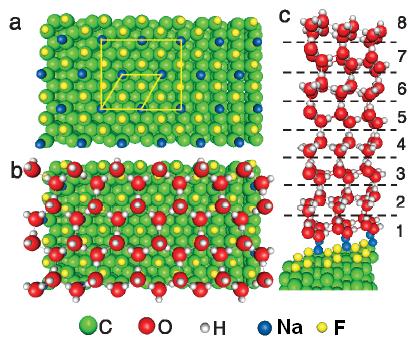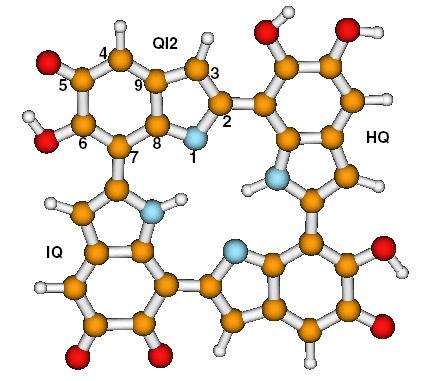分子和表面 (Bio)Molecules at surfaces
(a) Superphilic biocompatible substrates

The extreme limits of wettability, superphilicity and superphobicity, are immensely useful in practical applications such as self-cleaning surfaces, biomedic and nanofluidic devices. We have designed biocompatible, robust, superphilic substrates guided by the principles identified at the atomic scale. Such materials and devices are very useful to study biological processes in laboratory mimic that in living cells, and to a variety of applications such as sensors, transportation, heat transfer, and drug delivery.
Our desing is based on the (111) surface of diamond. The atomic structure of this surface is compatible with the crystal structure of ice. However, diamond (111) surface terminated by H atoms, has extreme hydrophobic behavior (super-hydrophobic). We proposed, based on extensive first-principles calculations, that by chemically modifying this surface with the proper type of elements, which partially substitute the H atoms, it would be possible to create a super-hydrophilic surface. Our simulations show that the ice layers on this surface should be stable at temperatures in the range of 310 K (body temperature). If this system can be formed experimentally, it would be an exciting possibility for biomedical applications.
(b) The DNA-carbon nanotube hybrid

The DNA-carbon nanotube (CNT) hybrid has received intensive interests recently. Both DNA strands and CNT are prototypical one-dimensional structures; the first plays a central role in biology, the second holds promise for analogous significance in nanotechnology applications. While each structure in its natural form is well established (e.g. the B-DNA form in solution, or isolated CNTs), their interaction has been the subject of intense investigation lately. For example, CNTs are proposed as the template for DNA encapsulation, intracellular DNA transport, DNA conformation transformation and ultrafast DNA sequencing. Single stranded DNA wrapping around CNTs in a diameter- and sequence-dependent manner, make it possible to dissolve the naturally hydrophobic CNTs in water and to sort them by their chirality, and to discriminate gaseous odors as a chemical sensor.
Recent success in detecting DNA conformational changes and hybridization by near-infrared fluorescence of CNTs or CNT-field-effect transistors also opens the possibility of DNA sequencing through electronic means. What is currently missing from all these attempts is a detailed understanding of the nature of the DNA-CNT interaction and its dependence on the nucleoside identity. Our recent study, based on realistic simulations and accurate quantum mechanical calculations, shows that this is an ideal system to perform tunneling experiments that can identify the DNA bases with 100% efficiency (Nano Lett. 7,45).
In addition, we have investigated DNA base orientations on single-walled CNT through an interplay between ultraviolet absorption spectroscopy and time-dependent density functional theory calculations. We develop an approach to determine the orientation of DNA bases relative to the nanotube axis, which agrees excellently with the spectroscopic measurements. These findings provide a first step towards a complete understanding of DNA-CNT interaction mechanism and could ultimately lead to ultrafast DNA sequencing (Nano Lett. 7,2312).
(c) Melanin

Melanin is a ubiquitous pigment in all living organisms with multiple fascinating functions including photoprotection, camouflage, radical scavenger, and playing a role in Vitamin D synthesis, malignant melanoma, and Parkinson's disease, yet strangely, its molecular structure is not understood. We have proposed a new structure model that contains a planar unit with a porphyrin-like ring for melanin protomolecules, which excellently explains the main body of experimental observations. Its unusual high, featureless optical absorbance, transferring photon energy into heat and electricity, and binding and releasing of metal ions without morphology changes, lead it to interesting applications such as bioeletronics, biosensors, energy storage, and photovoltaic devices, especially when in contact with materials such as semiconductors (PRL97,128102).
The excited states of melanin are very interesting. After uv excitation melanin quickly relaxes into the ground state by non-radiative pathways with a very low emission (less than 0.2%); about 90% uv energy is released as heat within a nanosecond. This is how melanin can play a photoprection role in our skin. More excitingly, a recent study suggests some fungi could utilize melanin to harvest high-energy X-ray and transfer it into chemical energy, analogous to photosynthesis in plants. The study of melanin could help us to learn the Nature's way of handling energy and even to conceive some new ways of harnessing solar light. Such investigations are underway in our group based on the new developments in TDDFT.
